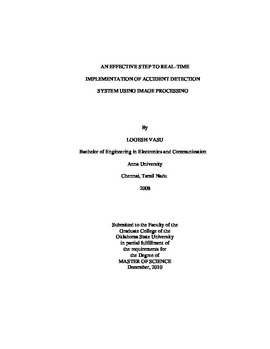| dc.contributor.author | Vasu, Logesh | |
| dc.date.accessioned | 2014-04-17T20:09:21Z | |
| dc.date.available | 2014-04-17T20:09:21Z | |
| dc.date.issued | 2010-12-01 | |
| dc.identifier.uri | https://hdl.handle.net/11244/10286 | |
| dc.description.abstract | Studies in the past have shown that number of traffic related fatalities is highly dependent on the emergency response time after the occurrence of an accident. Also traffic intersections were found to be one of the most vulnerable places for occurrence of an accident. Therefore there is a need to reduce the emergency response time by alerting the emergency response team by an automated accident detection system at traffic intersections, once an accident is detected. The goal of this project is develop an accident detection system at traffic intersections that is capable of operating in real-time with good performance rate. Therefore an accident detection system was developed which uses the vehicle parameters such as the speed and trajectory and other features such as area, orientation and position of the vehicle. Since one of the key elements in accident detection step is accurate tracking of moving vehicles, more focus was given to vehicle detection and tracking step. In this work, a tracking algorithm that uses a weighted combination of low-level features extracted from moving vehicles and low-level vision analysis on vehicle regions extracted from different frames is implemented. The speed of the tracked vehicles are calculated and along with the features extracted from the tracked vehicle, an accident detection system is designed which validates the factors cueing the occurrence of an accident. Once an accident is detected, the user is signaled about the occurrence of an accident. The detection and tracking performance of the algorithm was around 90% for two test videos used and collision detection system produced a correct detection rate of 87.5% for the test crashes simulated in the test bed setup in the laboratory. Overall the algorithm shows promise since it has a processing rate of 5frames/sec with good collision detection performance. With more test crashes and real-crashes data training, the performance of the algorithm is expected to improve. | |
| dc.format | application/pdf | |
| dc.language | en_US | |
| dc.publisher | Oklahoma State University | |
| dc.rights | Copyright is held by the author who has granted the Oklahoma State University Library the non-exclusive right to share this material in its institutional repository. Contact Digital Library Services at lib-dls@okstate.edu or 405-744-9161 for the permission policy on the use, reproduction or distribution of this material. | |
| dc.title | Effective Step to Real-time Implementation of Accident Detection System Using Image Processing | |
| dc.type | text | |
| osu.filename | Vasu_okstate_0664M_11240.pdf | |
| osu.college | Engineering, Architecture, and Technology | |
| osu.accesstype | Open Access | |
| dc.description.department | School of Electrical & Computer Engineering | |
| dc.type.genre | Thesis | |
| dc.subject.keywords | accident detection | |
| dc.subject.keywords | low-level features | |
| dc.subject.keywords | low-level vision | |
| dc.subject.keywords | vehicle detection and tracking | |
